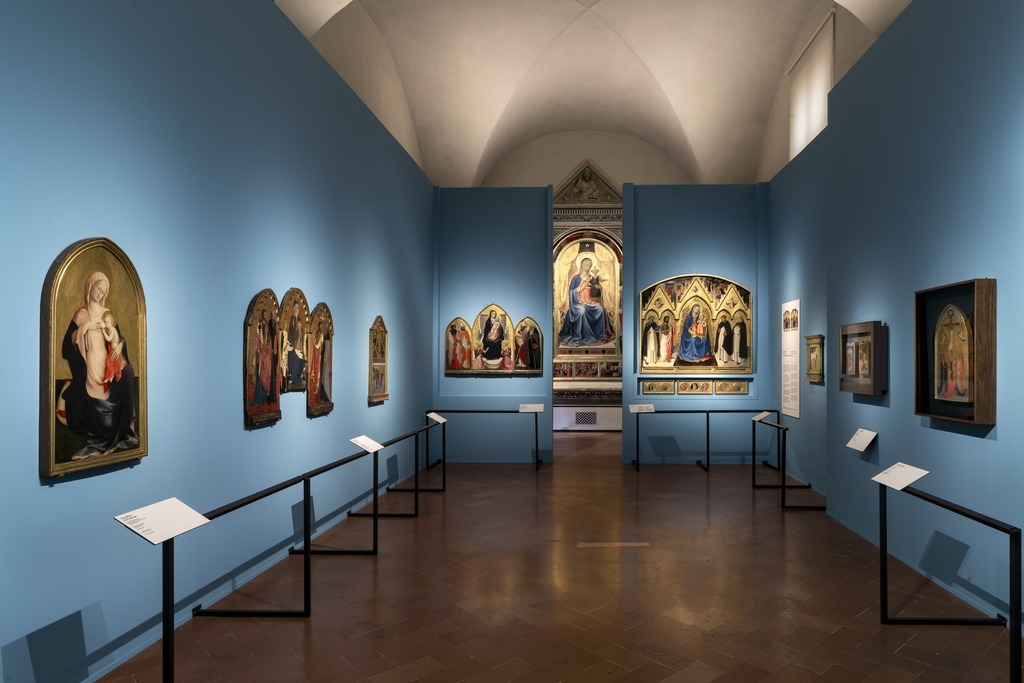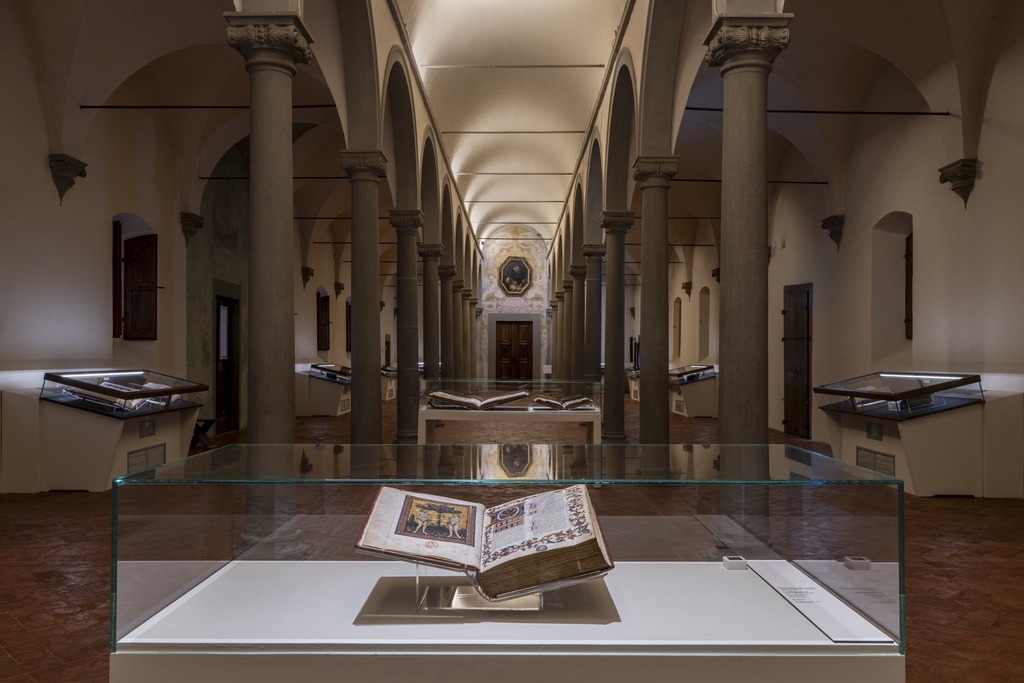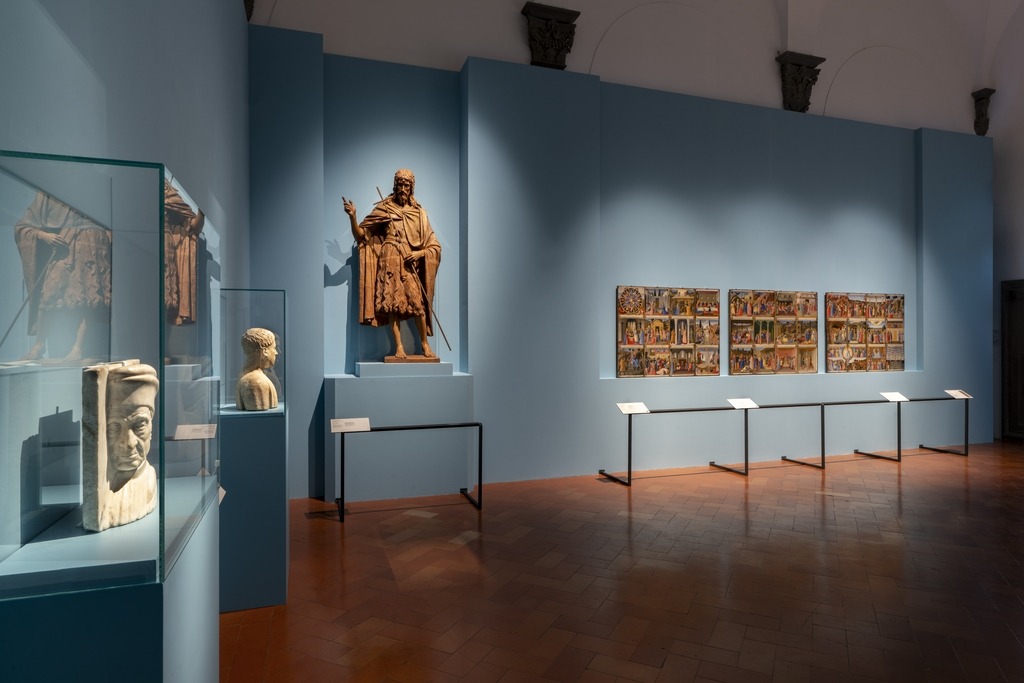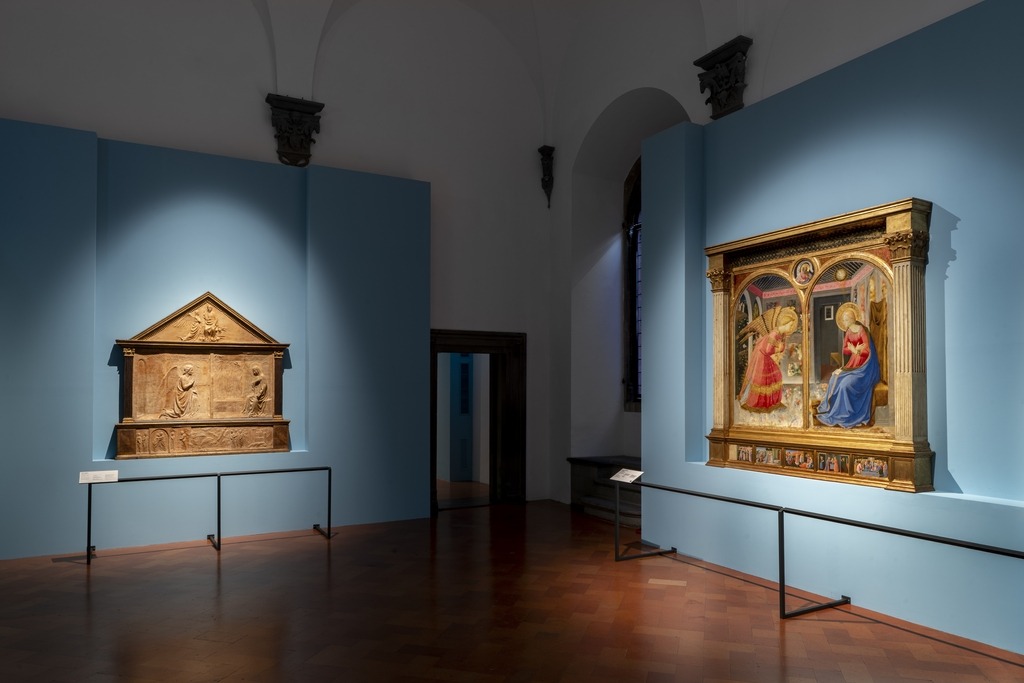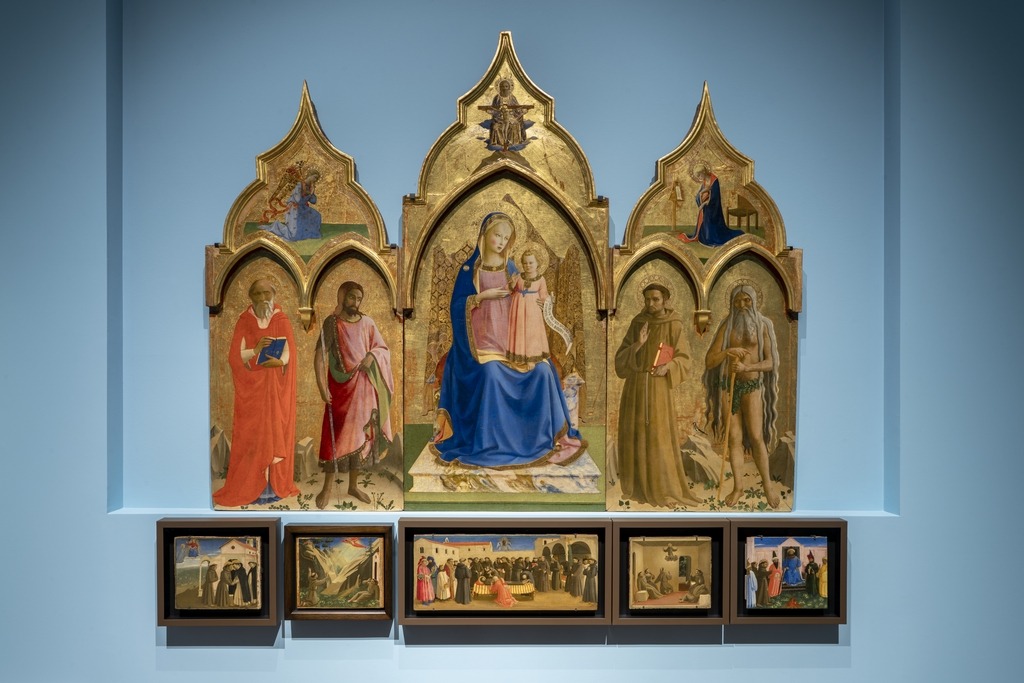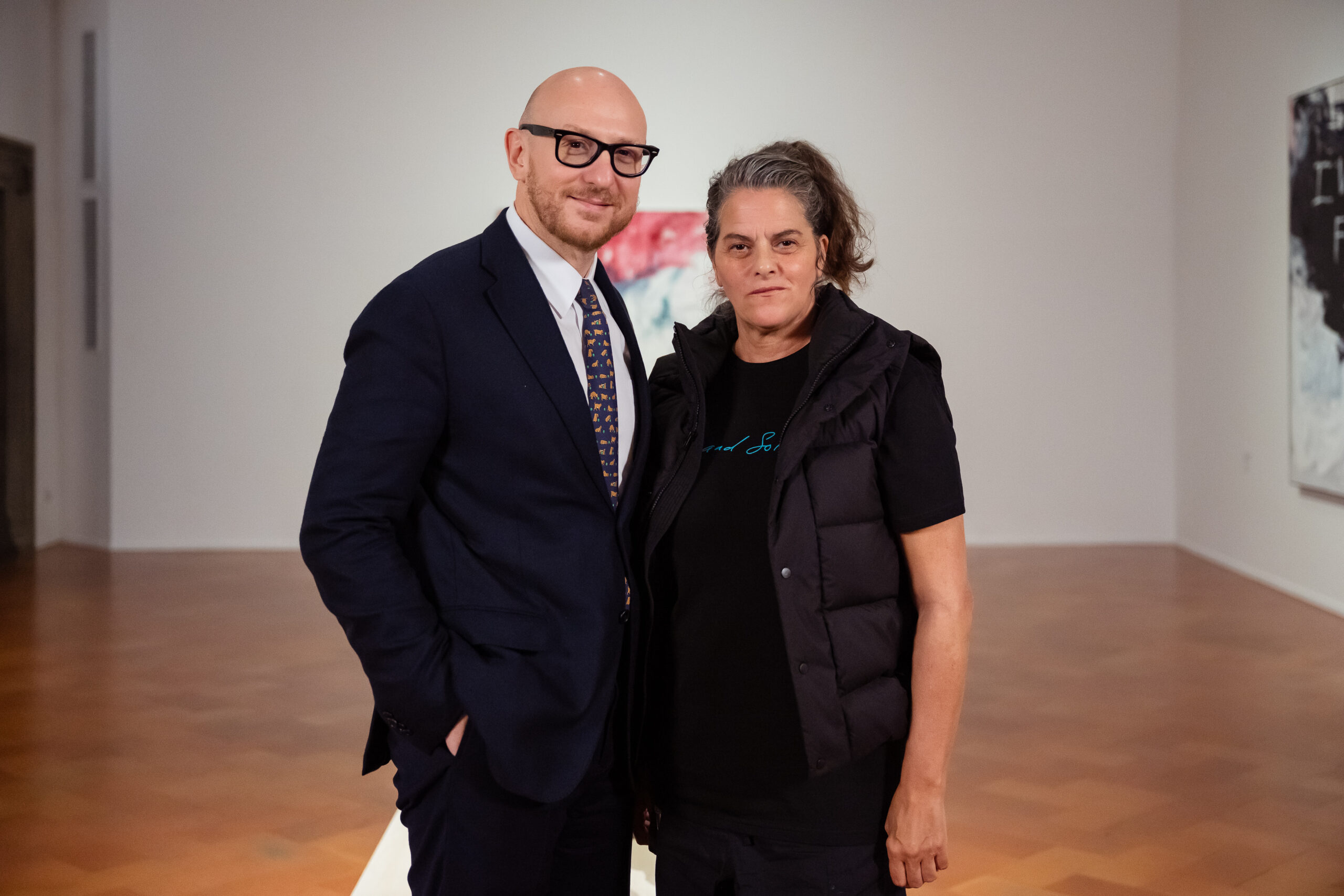Until 25 January 2026, Palazzo Strozzi and the Museum of San Marco are hosting the eagerly awaited exhibition dedicated to the 15th-century paintings of Beato Angelico, in dialogue with colleagues such as Lorenzo Monaco, Masaccio, Filippo Lippi and sculptors as Lorenzo Ghiberti, Michelozzo and Luca della Robbia. Curated by Carl Brandon Strehlke, curator emeritus of the Philadelphia Museum of Art, with Stefano Casciu, regional director of the National Museums of Tuscany, and Angelo Tartuferi, former director of the Museum of San Marco, the exhibition marks the artist’s “return” to the city seventy years after the 1955 monographic exhibition. If you are planning a visit to the exhibition, we suggest five works not to be missed, through the words of the experts contained in the catalogue published by Marsilio Arte
Altarpiece of the Compagnia di San Francesco in Santa Croce, called the Franciscan Triptych, 1428–29
This altarpiece is the only known commission to Fra Angelico from a confraternity associated with the mendicant order of the Franciscans, historically the rivals of the Dominicans. In 1991 John Henderson and Paul Joannides found a record that, in 1429, the Compagnia di San Francesco del Martello paid a ‘Fra Guido’ to execute an altarpiece for their chapel in the Franciscan convent of Santa Croce in Florence.
They associated the payment to the present triptych, whose main register was in poor condition, possibly explaining why it had been overlooked in art historical literature. This neglect particularly affected the side panels, long left in storage in the charterhouse at Galluzzo, earning the work the inaccurate name of the ‘Certosa Triptych’.
Despite its state of preservation, the importance of this work in Angelico’s career should not be underestimated.
It has a fundamental place in the development of the altarpieces that he produced. Its proportions are even more monumental than the altarpieces for San Domenico in Fiesole and San Pietro Martire. The Virgin at the centre is deliberately depicted as larger than the saints who flank her, treated almost like statues. The amount of precious materials—the gold ground, the lapis lazuli blue of her mantle, the brocaded cloth of honour, and the Baptist’s silver cross—is striking. The painter rendered hair with the care of an illuminator, in particular Saint Jerome’s beard and the long locks and body hair of the naked hermit saint Onuphrius.
This care for detail extends to the Annunciations on either side of the Trinity in the pinnacles. It is especially evident in the gilded mantle of God the Father; the ring on the Virgin’s finger, a sign of her fidelity to God; and the simple, realistic straw-bottomed chair behind her.
The splendour of the main register can now be appreciated following its restoration by the Opificio delle Pietre Dure in Florence for this exhibition, which, however, cannot conceal the extensive damage it has suffered over time. In the early seventeenth century, the chapel of the Compagnia di San Francesco was moved to the lower level of the convent, where it is believed that the altarpiece, still with the predella, was also transferred. In 1785 the confraternity was suppressed and the predella was probably dispersed, either at that time or when the convent of Santa Croce was suppressed in 1810. The main panels, harshly restored with caustic soda, were assigned to the Galleria dell’Accademia and then deposited in the Certosa del Galluzzo. Only the central panel, being in a better state, was later transferred to the Museo di San Marco.
The predella consists of five panels depicting stories of Saint Francis of Assisi. Three of them are in the Gemäldegalerie in Berlin: the Meeting of Saints Dominic and Francis of Assisi, the Apparition of Saint Francis of Assisi at Arles (both purchased in 1823 in Rome from Jakob Salomon Bartholdy), and the Funeral of Saint Francis of Assisi and Verification of the Stigmata (a gift in 1909 from the director general of the Berlin museums, Wilhelm von Bode, who had received the painting as the honorarium for a catalogue of John Pierpont Morgan’s bronzes; see Bode 1930, 1997 ed., 1, pp. 370–71). The Trial by Fire before the Sultan (acquired in 1845 in Rome) is in the Lindenau-Museum in Altenburg, while the Saint Francis of Assisi Receiving the Stigmata has been in the Musei Vaticani since at least 1837. Miklós Boskovits (1976b, pp. 36–38) first recognised that the predella belonged to this altarpiece.
In contrast to the rigidity of the main register with its canonical composition against gold ground, in the predella Angelico gave free rein to his imagination, depicting a landscape of unprecedented freshness (in the Meeting of Saints Dominic and Francis), nocturnes as surprising as they are mystical (in the scene of the stigmata and in the Apparition at Arles) or, in the Trial by Fire, a composition similar to a sacra conversazione that appears again in his pale quadre, starting with the San Marco Altarpiece. It is notable that the painter worked most boldly in a marginal section of the polyptych, namely the predella, where he laid the foundations for his future creations.
The original sequence of scenes in the predella has been discussed at length. Due to its size, twice as wide as the other scenes, the Validation of the Stigmata and Funeral of Saint Francis certainly occupied the central part. X-radiographic analysis conducted by the Opificio delle Pietre Dure in Florence for this exhibition (working closely with the three museums that house pieces of the predella) confirmed that the Meeting of Saints Dominic and Francis was on the far left followed by Saint Francis of Assisi Receiving the Stigmata and, to the right of centre, the Apparition of Saint Francis of Assisi at Arles followed by the Trial by Fire before the Sultan. The sequence of the stories is not chronological, and they seem to be ordered by a desire for a compositional balance between daytime and nocturnal scenes.
Neville Rowley
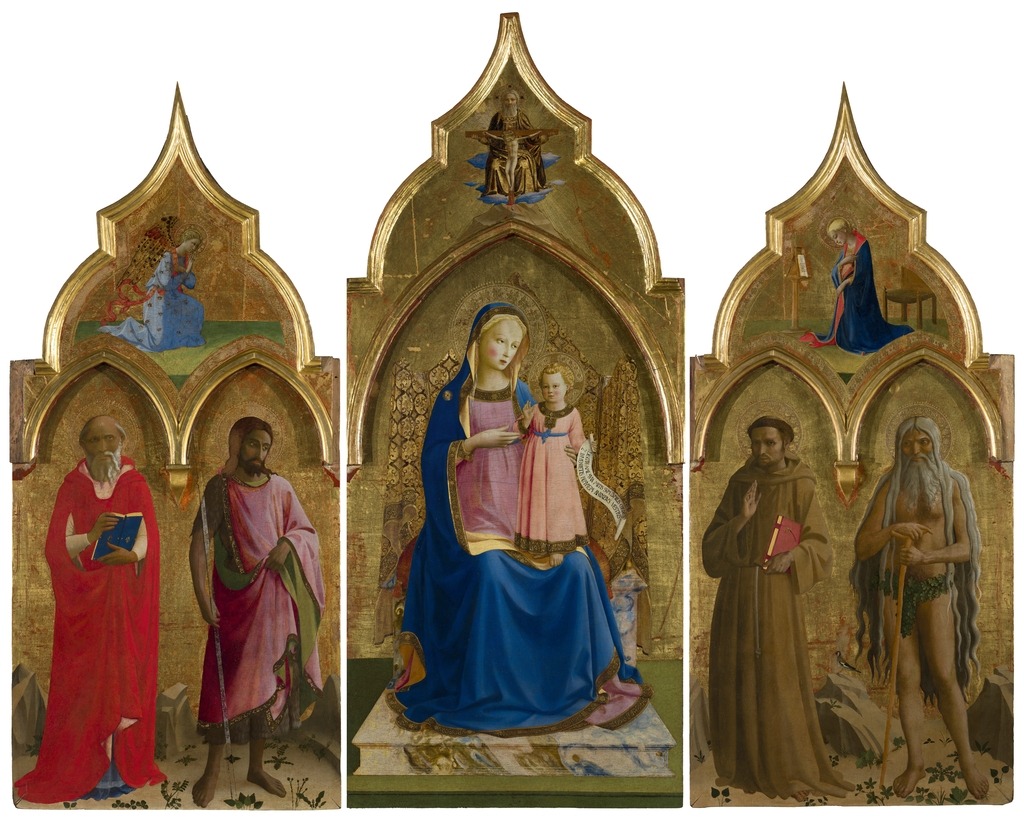
Fra Angelico, Altarpiece of the Compagnia di San Francesco in Santa Croce, called the Franciscan Triptych, 1428-29. Saints Jerome and John the Baptist, with the Annunciate Angel; Virgin and Child, with the Trinity; Saints Francis of Assisi and Onuphrius, with the Virgin Annunciate, tempera, gold, and silver on panel, 170 × 76.7 cm; 188.7 × 81.8 cm; 170.4 ×, 76.5 cm. Florence, Museo di San Marco, inv. 1890, no. 8496. Photo credits: courtesy Ministero della Cultura – Opificio delle Pietre Dure
Strozzi Altarpiece, c. 1421–24, c. 1430–32
Fra Angelico’s Deposition forms the central panel of an altarpiece commissioned by Palla Strozzi for his family’s sacristy in Santa Trinita. It was begun by Lorenzo Monaco and likely left unfinished at his death around 1424. Lorenzo Monaco’s contribution includes the pinnacles and predella (Pudelko 1939, pp. 78–79). Instead of a traditional Virgin and Child with saints, the subjects of the pinnacles suggest that a Passion scene was originally intended as the altarpiece’s principal subject (Padoa Rizzo 1987c).
Angelico was perhaps chosen to revise the altarpiece due to his close previous association with Lorenzo (Kanter 2005b).
Palla’s father, Onofrio (Nofri) di Palla di Messer Jacopo Strozzi (1345–1418), had bequeathed 2,000 florins for the construction and officiation of a chapel to be dedicated to Onuphrius, his name saint, and Nicholas of Bari, that of his late son Niccolò (d. 1411). Both dedicatees are notably absent in Gentile da Fabriano’s Adoration of the Magi, commissioned by Palla for the sacristy’s second chapel. In the Deposition, Palla has been identified as the figure holding the crown of thorns and nails. The kneeling figure could either be his eldest son, Lorenzo, who rose to political prominence in the years in which Angelico was completing the altarpiece (Strehlke 2005b, pp. 49–50; Strehlke 2008, pp. 172–73), or a depiction of the Blessed Alessio Strozzi (d. 1383), a revered family ancestor (Spike 1996, p. 106). The scene unfolds before a distant view of Jerusalem, its turreted walls reminiscent of Florence. Male and female mourners are divided beneath the Cross. The women, including key Gospel figures like the Virgin Mary and Mary Magdalene, are depicted in varying states of grief and prayer. Beside Palla, men dressed in contemporary Florentine clothing contemplate the Passion relics, drawing the narrative into the patron’s present and creating a diverse range of witnesses to Christ’s sacrifice. Naturalistic details, such as the marks of scourging on Christ’s body, the wood grain of the Cross, the flowing blood, and the carefully rendered foliage, invite the viewer into intimate contact with the sacred scene.
The painting was installed in July 1432, when compensation in the form of wine was paid to woodworker Manno di Benincasa for ‘raising’ the sacristy’s altarpiece and to Angelico’s convent of San Domenico in Fiesole (Jones 1984, pp. 67–68). In an early seventeenth-century list of artworks in Florentine churches (Catalogo delle Chiese c. 1637, fol. 13r), the Deposition was recorded as being above the main altar on the northeast side, though by 1755 it had been moved to another wall in the sacristy (Richa 1754–62, 3, 1755, p. 157). Upon the church’s suppression in 1810, it was removed and restored without its predella (Processi verbali 1810, fol. 196v; Affari diversi 1810–19, ins. 155, no. 2). Nevertheless, Antonio Maria Biscioni’s Sepoltuario (c. 1720, fol. 251) records the Deposition as bearing the Strozzi insignia above the sacristy door leading into the dormitory. These insignia were presumably on a lost part of the frame, perhaps the predella that was separated from the main panel when the altarpiece was removed, as no evidence of their presence remains. The predella, once consisting of a single plank, has lost its original framing, whereas the frame of the rest is original, except for the nineteenth-century carved foliage below the pinnacles and the Corinthian capitals that top the pilasters.
Details of the Deposition allow it to be recontextualized in the sacristy, which served not only as a burial chapel for Nofri Strozzi but also as the night choir for the church’s Vallombrosan community. In 1420 Palla had commissioned choir stalls from the woodworker Arduino da Baiso, following designs by Manno di Benincasa (Poggi 1903, pp. 16–17).
The relationship between the sacristy’s sepulchral function and the painting is reinforced by the original inscriptions on its frame: ‘Grieve over him, as one grieves at the death of the firstborn [Zachariah 10:12] / I am counted among them that go down into the pit [Psalms 87:5/88:4–5] / Behold in what manner the just one dies, yet no one comprehends Him in his heart [Isaiah 57]’. The first passage can be understood as a direct reference to premature deaths in the Strozzi family, including Niccolò di Nofri and the more recent death of Palla’s son Bartolomeo, who was buried in the sacristy’s crypt in July 1426. Palla’s 1447 testament also specified that he was to be buried there. The crypt was accessed by an eighteen-step stairway (Jones 1984, pp. 61, 92), and it may not be a coincidence that, in the Deposition, the two ladders have the same total number of steps.
Diane Cole Ahl (1977, p. 220) first observed that the scriptural passages cited in the inscriptions are taken from the matins and lauds for Holy Saturday, which would have been sung in the monks’ night choir before the altarpiece. Abbot Benigno Davanzati’s chronicle of the church records that the Good Friday ritual of the Adoration of the Cross took place in the sacristy (Davanzati 1740, fol. 286). The ritual involved the gradual uncovering of a cross while the barefoot Vallombrosan abbot prostrated himself three times before it, kissed it, and prayed before it (Baroffio 2013, pp. 204–05). In addition, a relic of the True Cross, owned by the Ardinghelli family and kept in the sacristy, was displayed every Good Friday to be kissed by the abbot, the Ardinghelli, and the congregation (Ricordanze 1579–94, fols. 128r–v). These practices are alluded to in the altarpiece by the barefoot Saint John sustaining Christ’s body, the figure kneeling before the Cross, and Mary Magdalene kissing Christ’s feet. The pictorial abbreviation of the key gestures of the ritual suggests that the altarpiece was conceived as a site-specific work for the sacristy to frame the Easter liturgies while maintaining allusions to its Strozzi patrons.
Michela Young
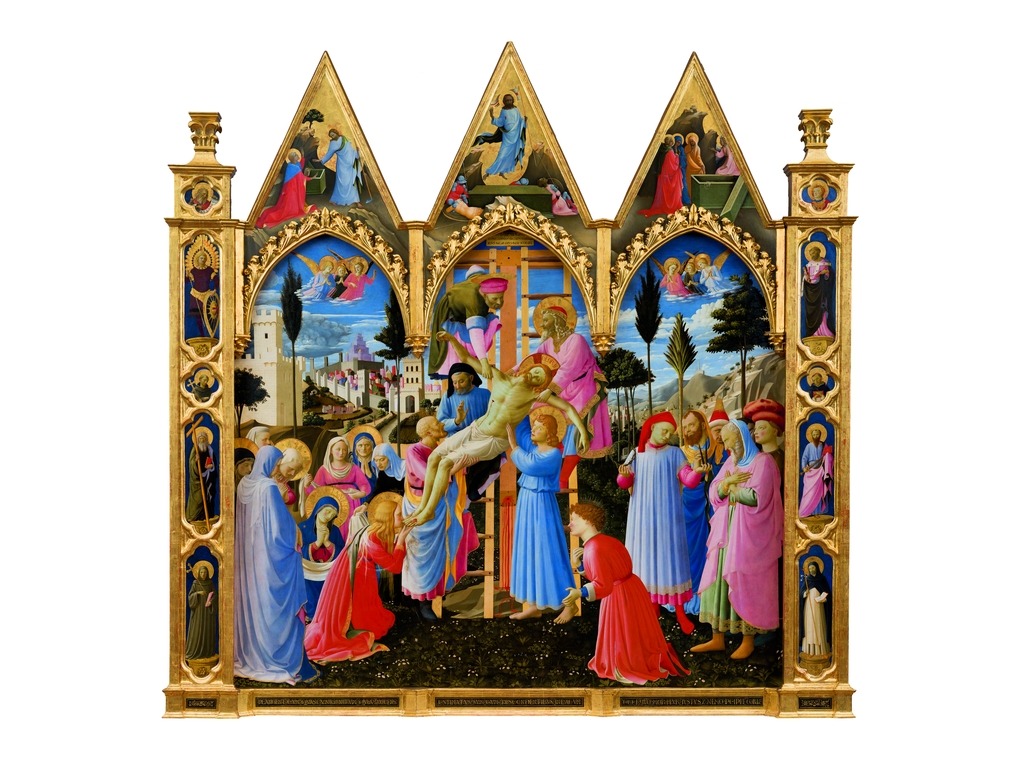
Lorenzo Monaco (Piero di Giovanni; Don Lorenzo), Siena, c. 1370–c. 1424 Florence, Fra Angelico (Guido di Piero; Fra Giovanni da Fiesole), Vicchio di Mugello c. 1395–1455 Rome, Strozzi Altarpiece, c. 1421-24; c. 1430–32, tempera and gold on panel, 277 x 283 cm (overall). Florence, Museo di San Marco, inv. 1890, no. 8509 (main section). Photo credits: courtesy Ministero della Cultura – Direzione regionale Musei nazionali Toscana – Museo di San Marco
Silhouetted Head of Saint Francis of Assisi, c. 1427–30
The painting on silhouetted panels depicts the crucified Christ between Saints Nicholas of Bari and Francis of Assisi kneeling at Mount Golgotha. The inscription, JESUS NAZARENUS REX JUDEORUM, is also transcribed in Greek and Hebrew. The work was commissioned by the Compagnia di San Niccolò di Bari, called the Ceppo, which was founded in 1417.
The Ceppo was one of Florence’s first four societates puerorum, adulescentium et iuvenum (organisations for boys, adolescents, and youths) dedicated to the teaching of Christian doctrine and its members’ spiritual upbringing (Taddei 2001).
The silhouetted crucifix was painted about a decade after the foundation of the association near the church and hospital of Santi Filippo e Jacopo della Torricella, not far from Santa Croce. In 1530 the brotherhood relocated to the Confraternita di Santa Maria della Croce al Tempio, and on 23 October 1564, to the present oratory in Via della Badessa (now Via de’ Pandolfini). In 1568 the painter Giovanbattista del Verrocchio was paid to repair damage to the crucifix caused by the flood of 1557. In 1594 Stefano Orlandi restored the painting for the high altar (Sebregondi 1985, pp. 30, 32, 47), as can be seen by an ex-voto depicting it in that position and attesting to its fame as a thaumaturgical object.
In 1610 the crucifix was replaced by a painting on canvas by Francesco Curradi and transferred to the sacristy.
To adapt it to the narrower dimensions of that room, the carpenter Vincenzo Sassi was assigned the task of ‘trimming two saints to make them smaller’ (Sebregondi 1985, pp. 33, 47), thus altering the proportions.
In 1955 the crucifix was transferred to the Museo di San Marco to be restored and displayed at the Angelico exhibition (Florence 1955b). After its return to the Ceppo and damage in the 1966 flood, repair of the support righted the position of the figures (Florence 1972). Following its second transfer to the museum, it was kept in the Sala del Lavabo until 2007, when enhanced security allowed for its relocation to the Ceppo.
In 2016–18 the work was restored at the Opificio delle Pietre Dure and the arrangement of the figures re-evaluated according to the golden triangle, at the centre of which was positioned Christ’s navel (Dinardo and Toso 2018).
In 1955 Umberto Baldini identified the upper part of the original Saint Francis in the Philadelphia Museum of Art. At the Ceppo, it had been substituted by a copy in oil that included the head and the torso, as well as the left arm and half of the right arm. The date this occurred is not known. The fragment was provided with a new background, and the figure falsely repainted so that the hands are clasped in prayer. In 1909 Bernard Berenson recommended the purchase of this work to the collector John G. Johnson, who acquired it two years later. In 1992 it was restored to its original contour (Strehlke 1993, pp. 9, 12; Strehlke 2018c; Carl Brandon Strehlke, in Madrid 2019). This exhibition is the first time that the two sections have been displayed together in Italy. Dating to approximately 1427–30, the crucifix group reflects Masaccio’s influence in the portrayal of the saints, Christ’s anatomy, and the fall of light. Francis’s head also recalls Lorenzo Ghiberti’s Saint Stephen at Orsanmichele (Carl Brandon Strehlke, in Madrid 2019, p. 190).
Ludovica Sebregondi
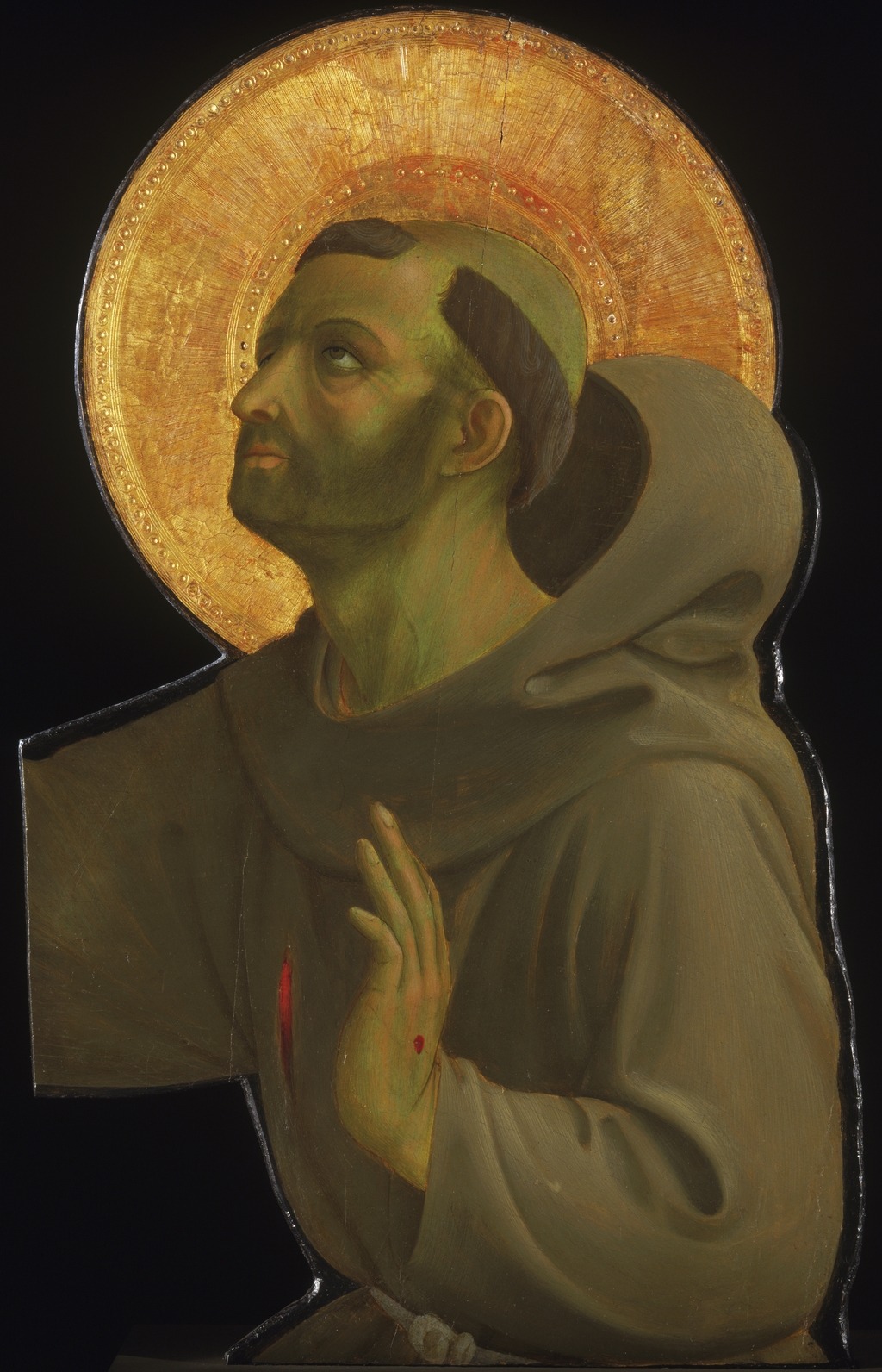
Fra Angelico, Silhouetted Head of Saint Francis of Assisi, c.1427-30, tempera and gold on panel, 70.5 × 48.9 cm. Philadelphia Museum of Art, John G. Johnson Collection, inv. 1917, cat. 14. Photo credits: Courtesy of the Philadelphia Museum of Art
Virgin of Humility, with Five Angels, c. 1425
Much as Dante in Paradiso (33.2) identified Mary as ‘more humble and sublime than any creature’, Fra Angelico has depicted her seated on the ground, or humus, as an example of humility, the origin of all Christian virtues, while simultaneously exalting her with a regal cloth of honour. As they hold up the fabric, three angels steal views of the Virgin and the child cuddling her cheek. In the foreground, two more angels gaze up at the scene, one resting its fingers on the keys of an organetto and the other holding a plectrum above the strings of a lute. It is a silent moment just before intoning and accompanying the ‘Ave Maria’ inscribed on her halo. This aureole is extraordinarily large and resembles the round brass trays that were much admired in Italy (Auld 2004), such as the fourteenth-century example made for a Yemenite sultan now in New York (The Metropolitan Museum of Art, no. 91.1.605), which, like the halo, has an elaborately ornamented inscription around the rim. Mary’s vase resembles an Egyptian or Syrian fourteenth-century ewer at the same museum (inv. 91.1.571). These references situate her in an imagined eastern Holy Land (Mack 2002, pp. 139–47). The vase holds a single lily among roses, the ‘lilium inter spinas’ of Song of Songs 2:2 to which the Virgin is compared. The baby offers a single pure-white lily, with which the bridegroom from Song of Songs 2:1 identifies himself, as in this both intimate and royal scene he is indeed his mother’s divine spouse.
It is one of Angelico’s first experiments with the theme. The short, rounded proportions of the figures suggest he painted the picture in the mid-1420s (Laurence B. Kanter, in New York 2005–06), and the Virgin’s strict frontality and the playful angels show Angelico’s direct response to Masaccio’s Sant’Anna Metterza of c. 1424–25 (Florence, Galleria degli Uffizi, inv. 1890, no. 8386).
The angels’ red wings and the red cruciform in Christ’s halo are marked by gold disks, possibly in reference to the red shield strewn with gold bezants of the Florentine Arte del Cambio, or Bankers’ Guild (Carl Brandon Strehlke, in Madrid 2019, p. 154), providing an indication of its original provenance. The guild commissioned other important works of art for its headquarters and associated institutions. Jacopo di Cione’s Coronation of the Virgin (Florence, Galleria dell’Accademia, inv. 1890, no. 456) adorned the guild house on the Piazza della Signoria, and Lorenzo Ghiberti’s statue of its patron saint, Matthew, adorned an exterior niche of Orsanmichele. In 1403 the guild brought the Saint Matthew Triptych by Andrea di Cione (Orcagna; Florence, Galleria degli Uffizi, inv. 1890, no. 3163) from its pier in the interior of that church to the hospital of San Matteo, of which it was superintendent (Artusi and Patruno 2000, pp. 247–56; Henderson 2006, pp. 138–40). Angelico’s picture may have been one of the Madonnas in tabernacles listed in a 1454 inventory of the hospital of San Matteo (see p. 243), just as Angelico’s Virgin of Humility now in Parma (cat. 6.1) seems to have come from another Florentine hospital. Alternatively, just as the guild of the linen workers kept the much larger tabernacle by Angelico (cat. 3.6) in their meeting hall, the bankers may have kept this Virgin of Humility in their headquarters. The guild was suppressed in 1781 and the hospital of San Matteo in 1784. The painting had made it to England by 1816, when it was given as a wedding gift to Princess Charlotte of Wales by her father, the prince regent and future King George IV.
Machtelt Brüggen Israëls
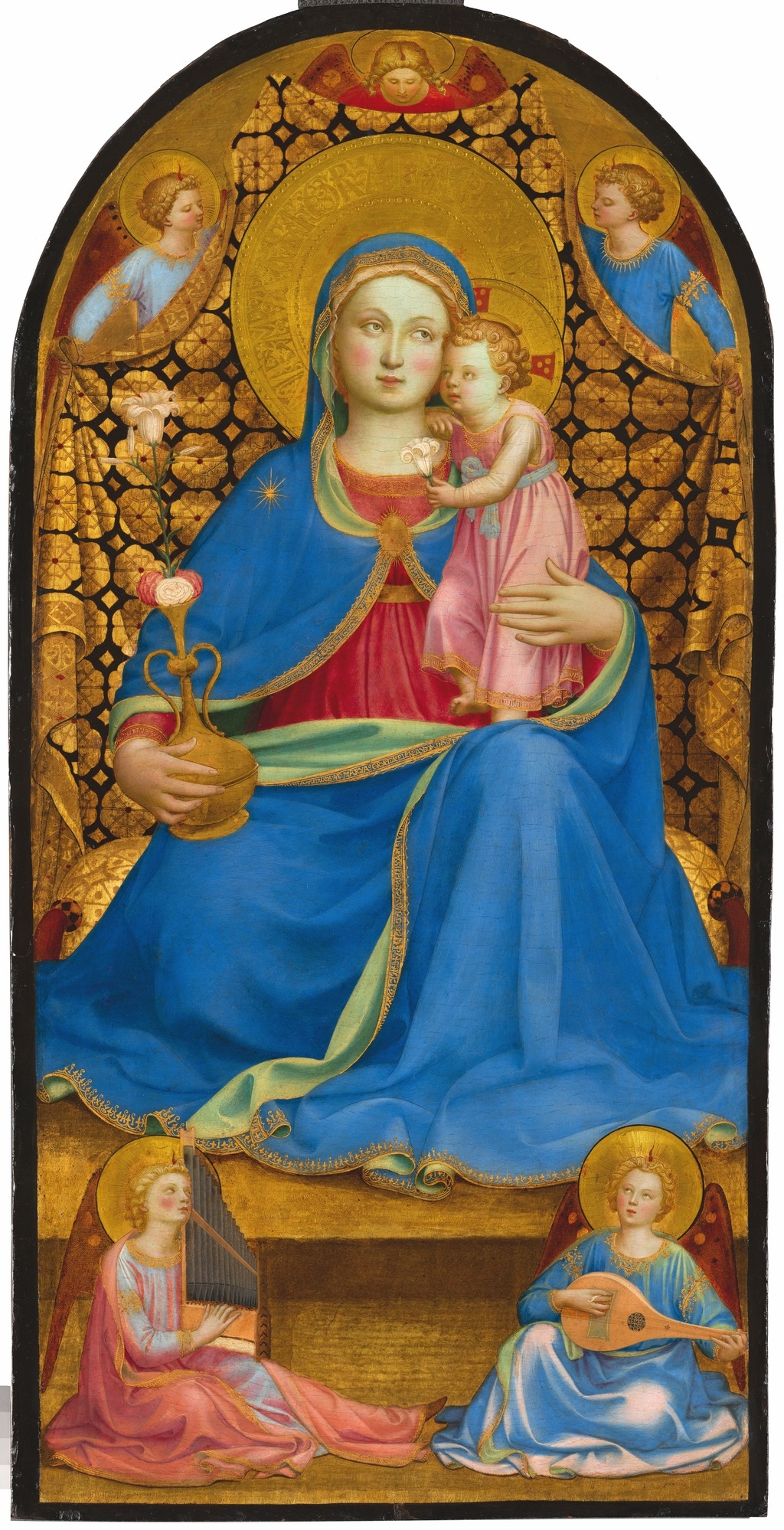
Fra Angelico, Virgin of Humility, with Five Angels, c. 1425, tempera and gold on panel, 98.6 × 49.2 cm. Barcelona, Museu Nacional d’Art de Catalunya, on long term loan from the Thyssen-Bornemisza Collection, Madrid inv. 7 (1986.10). Photo credits: © Museo Nacional Thyssen-Bornemisza, Madrid
Montecarlo Annunciation Altarpiece, c. 1432–35
Of Fra Angelico’s three surviving Annunciation altarpieces, the Montecarlo version is the most spatially ambitious. In it the artist exploited the unusual structure of the support to push the limits of illusionism.
The gilt frame mouldings, used to disguise the join between two separate round-topped panels, create an arcade like the one from which Gabriel enters. By painting the grey soffits below the gilt wooden arches and the capital and base at either side, Angelico integrated frame and pictorial space on the fourth side of the Virgin’s loggia, thereby creating a liminal opening onto the Incarnation.
The architectural setting was modified during execution. Incisions visible to the naked eye reveal that the walls were intended to have arches, contributing to a more uniform and simple space like that of the Cortona Annunciation. Angelico replaced the arches with marble panels painted in vaporous clouds of colour, perhaps to add a greater sense of variation, or varietas, a quality that his contemporaries appreciated in most art forms (Baxandall 1971, pp. 94–95).
The predella illustrates the same episodes as Angelico’s other Annunciation altarpieces and is most similar to the scenes in Cortona. In the Montecarlo altarpiece they were painted by at least one other artist, who, under the master’s direct supervision, apparently also contributed to the main panels. The colourful, wispy landscapes and the figures’ wide gazes resemble works by Zanobi Strozzi, Angelico’s associate and, until 1438, his neighbour (Kanter 2005d).
The altarpiece’s original destination is open to debate. Paul Joannides (1989, pp. 303–05) argued that the pentimenti and the construction of the support, in which cross-batons with a tongue-and groove join lock the two panels together, might mean that the picture was easily disassembled, and that it might, therefore, be identified with the Annunciation commissioned by Fra Francesco Landino of Florence in 1432 for the Servite church of Sant’Alessandro in Brescia, all traces of which have been lost. However, a chronicle of 1618 states that the Annunciation had indeed arrived in Brescia (Giani 1618–22, 1, 1618, p. 146). The carpentry of the Montecarlo Annunciation, while unusual, does not imply that the painting was intended to be shipped long-distance. The same system is found in Fra Filippo Lippi’s near-contemporary depiction of the subject in San Lorenzo.
More probably the painting was made for the church in which it was located until the twentieth century: that belonging to the Observant Franciscans at ‘Mons Carulus’, where before 1517 the Dominican Fra Mariano Fetti noted a work by the ‘devout and angelic’ friar painter (Orlandi 1964, p. 33n4). In 1429 the Florentine patrician Carlo Ricasoli donated the land to Franciscans despite the protests of the prominent humanist Poggio Bracciolini, who owned property nearby. Although the church does not have a secure consecration date (Amonaci 1997, p. 121), the altarpiece’s close similarities to Angelico’s documented paintings of the early 1430s suggest this Annunciation was painted around that time.
Maximillian Hernandez
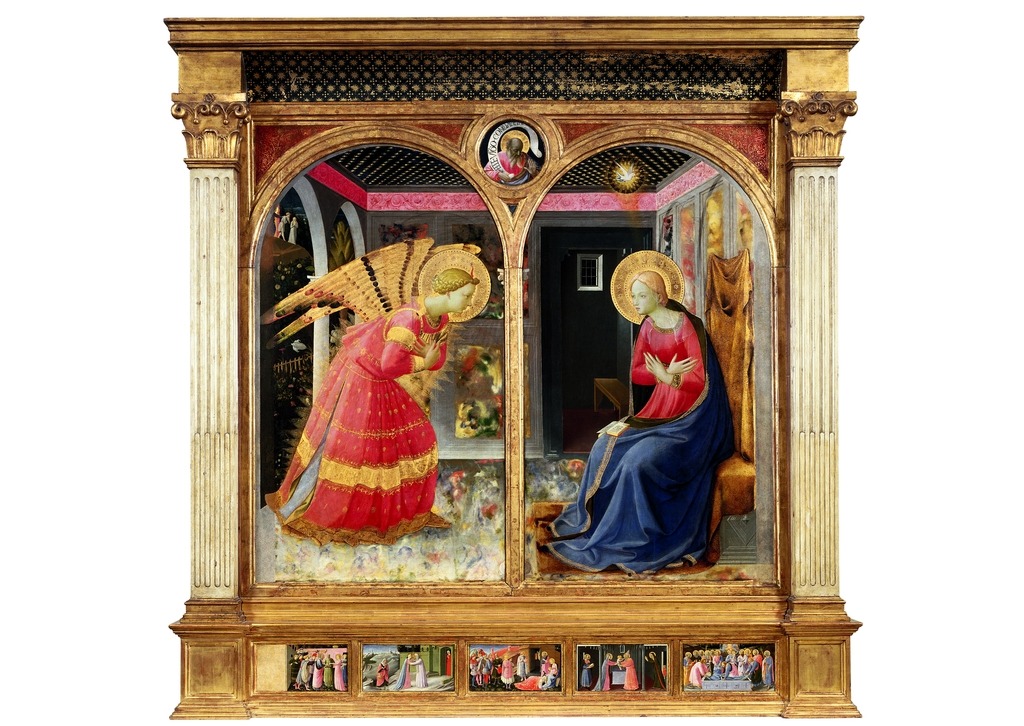
Fra Angelico and workshop, Montecarlo Annunciation Altarpiece. Annunciation with the Expulsion from Paradise; The Prophet Isaiah (roundel), Marriage of the Virgin; Visitation, Adoration of the Magi; Presentation in the Temple; and Dormition of the Virgin (predella), c. 1432-35, tempera and gold on panel, 195 × 158 cm (main section); 16 × 30 cm (each predella scene), San Giovanni Valdarno, Museo della Basilica di Santa Maria delle Grazie. Photo credits: Foto Scala, Firenze
The texts are taken from the exhibition catalogue published by Marsilio Arte, Venice 2025


INFO
Beato Angelico
until 25 January 2026
Palazzo Strozzi
Piazza Strozzi, Florence
https://www.palazzostrozzi.org/
Museo di San Marco
Piazza San Marco 3, Florence
https://museitoscana.cultura.gov.it/
Related Articles




